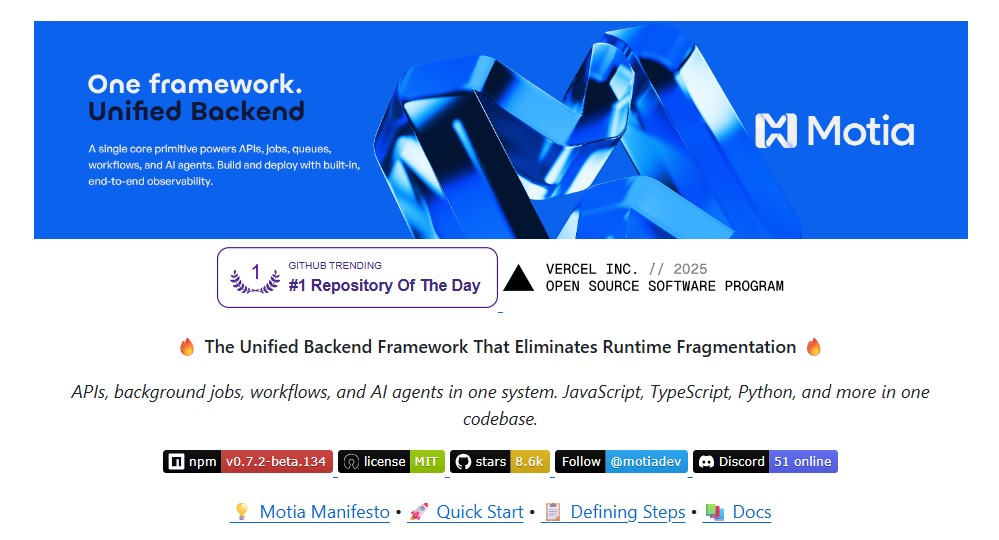In today’s software landscape, backend complexity has become one of the biggest bottlenecks for developers. APIs often live in one framework, background jobs in another, queue management in a third and AI agents in yet another isolated environment. This fragmentation slows down development, creates integration headaches and makes monitoring and scaling a nightmare.

Motia is changing that. Marketed as the “React for the backend” Motia unifies APIs, jobs, workflows and AI agents into a single cohesive framework. Instead of juggling five different runtimes, developers can now build, deploy and observe everything from one place.
Why Motia Stands Out ?
- Unified Architecture
Motia’s biggest strength is consolidation. It merges APIs, queueing, streaming, states, workflows, AI agents and observability into a single runtime. This eliminates the need for stitching multiple frameworks together and provides a consistent developer experience. - Multi-Language Support
Unlike most backend frameworks that lock you into one language, Motia supports JavaScript, TypeScript, and Python today with Ruby and Go coming soon. Teams can collaborate in their language of choice while staying within the same workflow. - Event-Driven Design
It is built for event-driven programming. APIs, background jobs, and AI workflows can interact in real time. This makes it particularly powerful for AI-driven applications like research agents, chatbots and automation pipelines. - Built-In Observability
Monitoring is often an afterthought in traditional frameworks. Motia changes that with visual debugging, tracing and real-time workflow inspection baked directly into the framework. Developers can easily spot bottlenecks and fix them before they hit production.
Real-World Use Cases
It isn’t just theoretical, it already powers several production-ready applications:
- ChessArena.ai – A real-time chess platform that benchmarks large language models (LLMs). It integrates authentication, a Python chess engine, real-time move streaming, live leaderboards and a React-based UI – all within Motia.
- AI Research Agents – Automating web research with iterative LLM analysis.
- Streaming Chatbots – Delivering live, AI-powered responses.
- Gmail Automation – Building workflows to handle emails intelligently.
- GitHub PR Manager – Automating code reviews and pull request workflows.
These examples highlight Motia’s versatility across automation, AI and production-ready platforms.
Getting Started in Under a Minute
One of Motia’s most appealing aspects is how fast developers can start building.
npx motia@latest create # Create a new project interactively
cd <project-folder>
npx motia dev # Launch server at http://localhost:3000
Within seconds, you’ll have:
- REST APIs with validation
- Visual debugger & tracing
- Multi-language workflows
- Event-driven architecture
- Zero configuration required
This simplicity makes Motia attractive not just for large-scale projects but also for quick prototypes.
The Roadmap Ahead
It is rapidly evolving with several exciting features on its roadmap:
- Python type support for stricter workflows
- Advanced queue strategies for complex job handling
- Reactive steps and point-in-time triggers
- Built-in database support
- A potential core rewrite in Go or Rust for blazing-fast performance
This forward-looking roadmap shows the project’s ambition to remain at the cutting edge of backend frameworks.
Why Developers Should Care
It solves a very real problem: runtime fragmentation. Instead of stitching together Express for APIs, Celery for jobs, Airflow for workflows, and LangChain for AI, developers can now build everything inside one framework.
The benefits are clear:
- Speed – Faster development with fewer moving parts.
- Flexibility – Multi-language support means teams can use what they know best.
- Scalability – Event-driven architecture and observability help production workloads scale smoothly.
- Future-Proofing – Native AI integration prepares developers for the next wave of intelligent applications.
Conclusion
Motia is more than just another backend framework – it’s a rethinking of how modern backends should be built. By unifying APIs, background jobs, workflows and AI agents under one system, it removes complexity and accelerates software delivery.
Whether you’re building an AI-powered chatbot, an automation pipeline or a real-time streaming app, Motia provides the foundation to do it faster and smarter.
With its strong community, expanding roadmap and production-ready examples, It is well-positioned to become the go-to backend framework for the next generation of developers.
Related Reads
- MLOps-Basics: A Step-by-Step Guide to Mastering Machine Learning Operations
- LLaMA-Factory: Simplifying Fine-Tuning for 100+ Large Language and Vision Models
- RAGFlow: Revolutionizing AI with Retrieval-Augmented Generation
- GraphRAG: The Future of Retrieval-Augmented Generation with Knowledge Graphs
- AgentScope: A Powerful Developer-Centric Framework for Building Agentic Applications

4 thoughts on “Motia: The Unified Backend Framework That Eliminates Runtime Fragmentation”